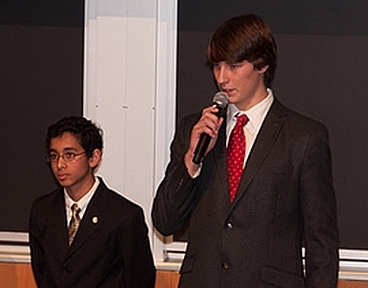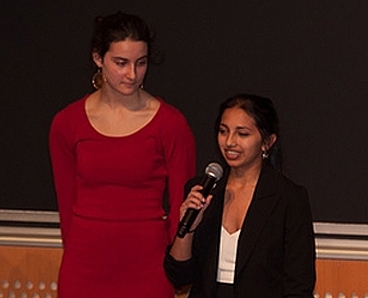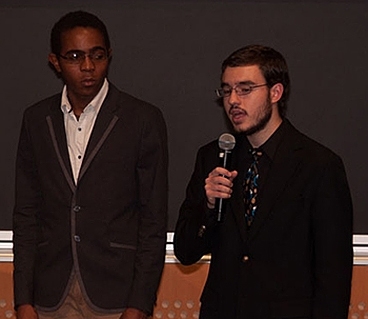Editor's note: Bennett Cyphers is a freshman from Plattsburgh, N.Y. who has taken two Terrascope classes, 12.000 and 1.016. He is majoring in Electrical Engineering and Computer Science and enjoys ruminating on the problems of the world.
Sixty people sit in a room. They come from a variety of backgrounds, and few of them know each other. As they watch in silence, a professor in the front of the room lays out their task for the next three months: it will require intense research, a myriad of disciplines, creativity, effective teamwork — and if they are to be successful — a staggering amount of effort. This is no strategic meeting of industry experts, nor is it a graduate or post-graduate seminar. This is 12.000, Solving Complex Problems, and every student seated in the auditorium is a first-semester freshman at MIT.
Each year in 12.000, the flagship course in the Terrascope program and something of an anomaly among freshman-level classes, students are given just one problem. For Mission 2016, as the class was known colloquially (the 2016 refers to the graduation year of participants), the subject was “The Future of Strategic Natural Resources.” Topics from previous years have included carbon sequestration, the biodiversity crisis, global hunger and planning a mission to Mars. If these projects sound vague and a little intimidating, it is not by accident. “[Terrascope] is designed to provide students the opportunity to work as part of a team to propose solutions to a complex or ‘unsolveable’ problem that requires a strongly interdisciplinary approach,” according to the official website. There are no tests or p-sets, and after the first couple of weeks, the professor and teaching staff tries only to facilitate progress and not intervene in the operation of the class. Students are treated as scientists and engineers capable of synthesizing research and formulating solutions — not freshmen.
For most of the semester, students are expected to self-organize and seek the counsel of UTFs, a group of undergraduate TAs selected from previous 12.000 classes. The free-form dynamic is meant to mimic real-life working conditions, but it often leads to a period of creative stagnation before students gain momentum. UTF and Mission 2015 participant Nikki Neibloom explains: “It definitely takes a few weeks before everyone realizes what they should be doing. For most of September, people are just kinda running around, trying to figure out what to do, but by Thanksgiving, everyone is laser-focused.” The students are also encouraged to seek help from other MIT professors, librarians and a group of 16 alumni mentors specifically associated with the program.
As with all topics chosen for Mission, the subject of strategic resource management is especially relevant now. Included in strategic natural resources are minerals that have crucial applications in the modern global economy. Examples include phosphorus, which is irreplaceable in modern agriculture; the fissile elements uranium and plutonium, which power reactors and nuclear weapons; and rare earth metals, used in everything from clean energy to car batteries to cell phones. However, many of these are scarce, difficult to obtain or experiencing stratospheric increases in demand. Some are potentially dangerous. Mission 2016 was tasked with devising a plan to ensure that all nations in the world, including those still developing, have access to strategic resources for the future by implementing effective, sustainable, environmentally sensitive policies.
In the last week of November, the solution the students have assembled is put to the test. Grading for Terrascope, like everything else, is unconventional, and students pass or fail based on a combination of their individual effort and the performance of the whole class. The deliverables are a website detailing the finished plan and a grueling, three-hour presentation in front of a panel of experts. The students spend the final days of the class assembling their mountains of work into an organized, coherent whole ready for professional scrutiny. On Nov. 28, 2012, Mission 2016 came to a close, as students gave a one-hour presentation outlining their solution, followed by a two-hour Q&A session, in which they defended their semester’s work.
After the class concluded, just before Finals week, everyone involved was drained. However, at least a few of the students who just finished spending numbing hours on an impossible problem plan to do it again in the spring. “It was definitely tough, but it’s an experience I wouldn’t get anywhere else. I already signed up for 1.016 in the spring, and I’m looking forward to it,” says Victoria Stivanello ‘16. The program offers ample opportunity to continue with it after 12.000. There are two second-semester classes: 1.016, also known as ‘Terrascope lab,’ and SP.360, Terrascope radio.
Many of the members of Mission 2016 will travel to California over spring break to explore mine sites relevant to their research, and freshmen can apply to become UTFs for the years ahead.
Sixty people sit in a room. They come from a variety of backgrounds, and few of them know each other. As they watch in silence, a professor in the front of the room lays out their task for the next three months: it will require intense research, a myriad of disciplines, creativity, effective teamwork — and if they are to be successful — a staggering amount of effort. This is no strategic meeting of industry experts, nor is it a graduate or post-graduate seminar. This is 12.000, Solving Complex Problems, and every student seated in the auditorium is a first-semester freshman at MIT.
Each year in 12.000, the flagship course in the Terrascope program and something of an anomaly among freshman-level classes, students are given just one problem. For Mission 2016, as the class was known colloquially (the 2016 refers to the graduation year of participants), the subject was “The Future of Strategic Natural Resources.” Topics from previous years have included carbon sequestration, the biodiversity crisis, global hunger and planning a mission to Mars. If these projects sound vague and a little intimidating, it is not by accident. “[Terrascope] is designed to provide students the opportunity to work as part of a team to propose solutions to a complex or ‘unsolveable’ problem that requires a strongly interdisciplinary approach,” according to the official website. There are no tests or p-sets, and after the first couple of weeks, the professor and teaching staff tries only to facilitate progress and not intervene in the operation of the class. Students are treated as scientists and engineers capable of synthesizing research and formulating solutions — not freshmen.
For most of the semester, students are expected to self-organize and seek the counsel of UTFs, a group of undergraduate TAs selected from previous 12.000 classes. The free-form dynamic is meant to mimic real-life working conditions, but it often leads to a period of creative stagnation before students gain momentum. UTF and Mission 2015 participant Nikki Neibloom explains: “It definitely takes a few weeks before everyone realizes what they should be doing. For most of September, people are just kinda running around, trying to figure out what to do, but by Thanksgiving, everyone is laser-focused.” The students are also encouraged to seek help from other MIT professors, librarians and a group of 16 alumni mentors specifically associated with the program.
As with all topics chosen for Mission, the subject of strategic resource management is especially relevant now. Included in strategic natural resources are minerals that have crucial applications in the modern global economy. Examples include phosphorus, which is irreplaceable in modern agriculture; the fissile elements uranium and plutonium, which power reactors and nuclear weapons; and rare earth metals, used in everything from clean energy to car batteries to cell phones. However, many of these are scarce, difficult to obtain or experiencing stratospheric increases in demand. Some are potentially dangerous. Mission 2016 was tasked with devising a plan to ensure that all nations in the world, including those still developing, have access to strategic resources for the future by implementing effective, sustainable, environmentally sensitive policies.
In the last week of November, the solution the students have assembled is put to the test. Grading for Terrascope, like everything else, is unconventional, and students pass or fail based on a combination of their individual effort and the performance of the whole class. The deliverables are a website detailing the finished plan and a grueling, three-hour presentation in front of a panel of experts. The students spend the final days of the class assembling their mountains of work into an organized, coherent whole ready for professional scrutiny. On Nov. 28, 2012, Mission 2016 came to a close, as students gave a one-hour presentation outlining their solution, followed by a two-hour Q&A session, in which they defended their semester’s work.
After the class concluded, just before Finals week, everyone involved was drained. However, at least a few of the students who just finished spending numbing hours on an impossible problem plan to do it again in the spring. “It was definitely tough, but it’s an experience I wouldn’t get anywhere else. I already signed up for 1.016 in the spring, and I’m looking forward to it,” says Victoria Stivanello ‘16. The program offers ample opportunity to continue with it after 12.000. There are two second-semester classes: 1.016, also known as ‘Terrascope lab,’ and SP.360, Terrascope radio.
Many of the members of Mission 2016 will travel to California over spring break to explore mine sites relevant to their research, and freshmen can apply to become UTFs for the years ahead.








